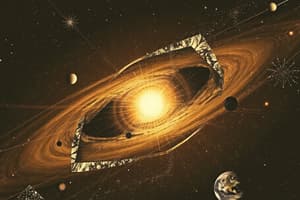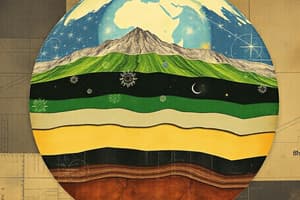Podcast
Questions and Answers
Terrestrial planets are composed mainly of silicate minerals like aluminum, iron, and magnesium.
Terrestrial planets are composed mainly of silicate minerals like aluminum, iron, and magnesium.
True (A)
The most abundant silicate mineral in our Solar System is quartz.
The most abundant silicate mineral in our Solar System is quartz.
False (B)
Metals like iron, nickel, and magnesium make up around 50% of a terrestrial planet's mass.
Metals like iron, nickel, and magnesium make up around 50% of a terrestrial planet's mass.
False (B)
Volatiles such as water, carbon dioxide, and other gases form the bulk of solid matter in terrestrial planets.
Volatiles such as water, carbon dioxide, and other gases form the bulk of solid matter in terrestrial planets.
Our Solar System's four inner planets are classified as gas giants.
Our Solar System's four inner planets are classified as gas giants.
The primary constituents of Jupiter and Saturn are hydrogen and helium.
The primary constituents of Jupiter and Saturn are hydrogen and helium.
Methane, ammonia, and water ice are found in the deeper layers of gas giants like Jupiter and Saturn.
Methane, ammonia, and water ice are found in the deeper layers of gas giants like Jupiter and Saturn.
Uranus and Neptune have rock and metal cores that are larger than those of gas giants.
Uranus and Neptune have rock and metal cores that are larger than those of gas giants.
Hydrogen and helium are present in smaller quantities in Uranus and Neptune compared to gas giants.
Hydrogen and helium are present in smaller quantities in Uranus and Neptune compared to gas giants.
The evolutionary processes that shaped our Solar System determined the composition of gas giants to be richer in silicate minerals and metals.
The evolutionary processes that shaped our Solar System determined the composition of gas giants to be richer in silicate minerals and metals.
Flashcards are hidden until you start studying
Study Notes
Planetary Composition: Exploring the Building Blocks of Our Solar System's Worlds
Ever since ancient civilizations gazed up at the night sky, humans have been captivated by the enigma of celestial bodies known as planets. These orbiting spheres of gas, rock, and ice are a fascinating blend of elements and compounds that reveal a lot about our universe's history and complexity. To better understand these cosmic wonders, let's delve into their composition, which can be broadly categorized into the following subtopics.
Terrestrial Planets
Also known as rocky planets, these worlds are composed primarily of silicate minerals, such as aluminum, iron, magnesium, and silicon. Our Solar System's four inner planets—Mercury, Venus, Earth, and Mars—are classified as terrestrial. The elements in these planets consist of two primary constituents:
-
Silicates: These minerals, comprised mainly of aluminum, silicon, and oxygen, form the bulk of solid matter in terrestrial planets. The most abundant silicate mineral in our Solar System is feldspar.
-
Metals: Iron, nickel, and magnesium account for approximately 30% of a terrestrial planet's mass. These metals are found in various mineral forms, such as olivine and pyroxene.
-
Volatiles: Water, carbon dioxide, and other gases make up the remaining fraction of a terrestrial planet's mass. These volatiles are essential to the formation and evolution of terrestrial planets, as they influence factors such as surface temperature and atmospheric pressure.
Gas Giants
Jupiter and Saturn, along with Uranus and Neptune, are the four enormous planets orbiting far from our Sun. These colossal worlds consist mostly of hydrogen and helium, with traces of other elements like water, methane, and ammonia.
-
Hydrogen: This lightweight element is the principal constituent of Jupiter and Saturn. Ganymede, a moon of Jupiter, has a surface composed almost solely of hydrogen ice.
-
Helium: This inert gas is the second most abundant element in gas giants, making up about 10-15% of their mass. Helium is also found in the upper layers of Jupiter and Saturn's atmospheres.
-
Ices: Methane, ammonia, and water ice are the other essential elements in gas giants. These compounds are found in considerable amounts in the deeper layers of these planets.
Ice Giants
Uranus and Neptune are often classified as ice giants, despite their significant hydrogen and helium content. The term "ice giant" is more descriptive of these planets' surfaces, which are comprised mostly of frozen water, methane, and ammonia.
-
Ices: Frozen water, methane, and ammonia compounds make up the primary constituents of Uranus and Neptune's surfaces.
-
Rock and metal cores: Like gas giants, ice giants also have cores of rock and metal. However, their core sizes are much smaller than those of gas giants, accounting for only a small fraction of their overall mass.
-
Hydrogen and helium: These gases are also present in the deeper layers of Uranus and Neptune, although in smaller quantities than in the gas giants.
Planetary Evolution and Composition
Planetary composition can reveal much about the evolutionary processes that shaped our Solar System. For example, the Sun's early formation created a disk of gas and dust, from which terrestrial and gas giants formed. The distance from the Sun determined the composition of each type of planet, as gas giants accumulated more hydrogen and helium, while terrestrial planets became richer in silicate minerals and metals.
Understanding planetary composition is also valuable for exploring the possibility of finding life beyond Earth. Scientists worldwide search for planets with similar compositions to our own, in hopes of finding evidence of life in their atmospheres or the potential for habitability.
In summary, planets are diverse celestial bodies composed of various elements and compounds. Their compositions reveal fascinating insights into the formation and evolution of our Solar System. As we continue to explore the cosmos, including the search for exoplanets, understanding planetary composition will be a vital aspect of our exploration and discovery.
Studying That Suits You
Use AI to generate personalized quizzes and flashcards to suit your learning preferences.




